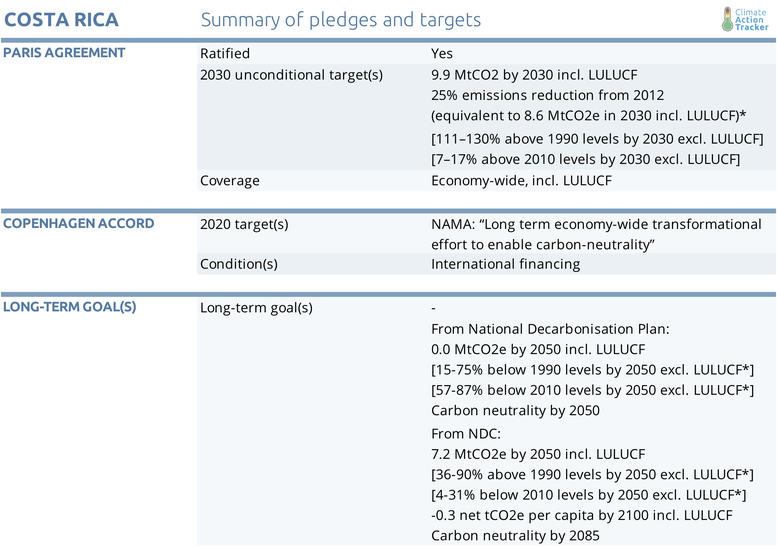Pledges And Targets
Summary table

Paris Agreement targets
Costa Rica’s NDC includes a target of 9.4 MtCO2e emissions in 2030 and an indicative emissions level of 10.9 MtCO2e emissions by 2021 (including LULUCF with global warming potentials, GWPs, from the IPCC’s Second Assessment Report, SAR). The CAT estimates the targets to be 13.9 MtCO2e excluding LULUCF for the 2021 projections and between 13.7 MtCO2e and 15.0 MtCO2e excluding LULUCF for 2030 in GWPs from the IPCC’s fourth assessment report (see “Assumptions” section for details). For 2030, this is equivalent to an increase between 111% and 130% above 1990 levels excluding LULUCF. Costa Rica additionally set a per capita emissions target of 1.7 tCO2e in 2030.
2020 pledge
In 2011, Costa Rica communicated the implementation of a “long-term economy-wide transformational effort to enable carbon-neutrality”, that is, to have zero net emissions including LULUCF (UNFCCC, 2011). In its previous assessments, the CAT interpreted this target to mean carbon neutrality by 2021, based on the National Climate Change Strategy (ENCC) from 2008 (Ministerio de Ambiente Energia y Telecommunicaciones, 2009).
In its 2015 NDC (Ministerio de Ambiente y Energía, 2015b), Costa Rica gave a completely different interpretation of its carbon neutrality goal, namely being carbon neutral by 2085, starting in 2021. Indeed, according to the NDC, the definition of carbon neutrality by 2021 was changed to “(achieve) total net emissions comparable to total emissions in 2005”. The reasons for the change in the interpretation of the pledge, which in practical terms means a delay in climate action of 64 years, are unclear. Compared to the pledge, however, the NDC is more precise. The NDC provides exact net emission projections for 2021 (13.9 MtCO2e in GWPs from AR4).
In 2019, Costa Rica again announced its goal to be carbon neutral—this time by 2050 (Gobierno de Costa Rica, 2019b). It is unclear whether this carbon neutrality goal supersedes Costa Rica’s NDC targets, which are less ambitious. Costa Rica plans to submit an updated NDC in 2020. As stated on their National Decarbonisation Plan, this and other planning documents will inform the NDC update process (ibid).
Long-term goal
In February 2019 Costa Rica presented its National Decarbonisation Plan 2018-2050 (Gobierno de Costa Rica, 2019b). In this document Costa Rica sets a national target of net-zero emissions in 2050—emissions including LULUCF—and describes a roadmap towards achieving this target. According to the sectoral breakdown provided in the plan, emissions in 2050 will be 5.5 MtCO2e excluding LULUCF. This plan’s pathway towards decarbonisation has been modelled as a linear decrease between 2020 and 2050. For 2030, the decarbonisation pathway is between 2.5 MtCO2e and 3.7 MtCO2e under Costa Rica’s NDC target.
There is no clarity on whether the National Decarbonisation Plan replaces Costa Rica’s NDC 2030 and long-term target as it has not yet submitted an NDC to the UNFCCC, but this is expected in 2020. This decarbonisation pathway is more ambitious than Costa Rica’s 2050 NDC target. The NDC long-term target aims at keeping emissions below 7.2 MtCO2e by 2050 including LULUCF with GWPs from AR4 (Ministerio de Ambiente y Energía, 2015b). In its NDC, Costa Rica additionally sets per capita emissions targets of 1.2 tCO2e in 2050, and - 0.3 tCO2e in 2100 (both of which with SAR GWPs). For the 2050 NDC target, we have estimated a range for the 2050 target based on our assumptions of LULUCF projections given that Costa Rica only provided LULUCF projections until 2030 (see “Assumptions” section for details). We do not include the 2100 target in our analysis.
Further analysis
Latest publications
Stay informed
Subscribe to our newsletter




